Hey, everybody. TJ, the CEO of the Outdoor Hobby Hub here. Hope you’re all enjoying Spring and getting back outside as we are in my family.
One way we’ve started to do that is by getting out our Disc Golf gear and treading the (slightly boggy) fields and courses. Here in Michigan it’s still a bit cold, and often rainy, but that doesn’t stop those of us that love to be under the wide open sky!
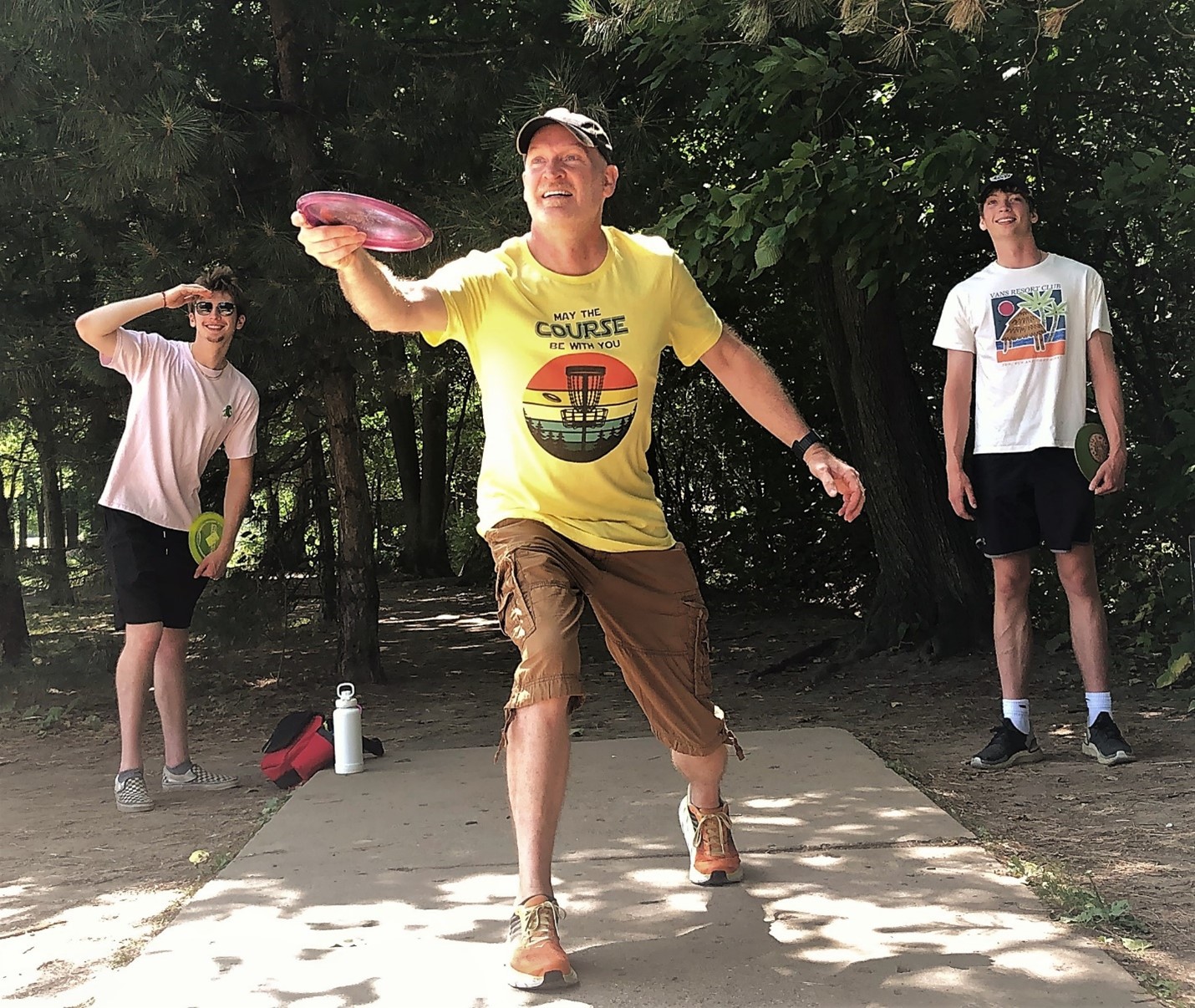
One of my absolute favorite outdoor sports has always been Frisbee Football, but in the last few decades, I’ve expanded from that into Disc Golf too. That’s my son, his friend & I playing in the picture above.
Disc golf is as fun as Frisbee Football, but definitely less “impactful” to the bones & skin… a definite boon when you’ve passed 40 as I have. For some reason I don’t like getting HIT as much as I used to, ya know? LoL
In any case, this Introduction to Disc Golf post, I’ll share why I love it so much & perhaps teach you some things you didn’t know.
If you’re just looking into it, Disc Golf is a fantastic way to have fun, stay active outdoors and introduce a little friendly competition between you and those you like to spend time with. It’s an American-born sport that you can share with friends or your whole family, regardless of their age. Well, okay, if they’re 5 or under, maybe not. But if they’re that young, they’ll enjoy being pushed around the course by you, And think of the incredible exercise you’ll get!
From its humble beginnings as a backyard pastime, to its current state as a competitive sport played around the world, Disc Golf has captured the hearts of outdoor enthusiasts everywhere.
So flex your wrists and get ready… for this ultimate guide to disc golf!
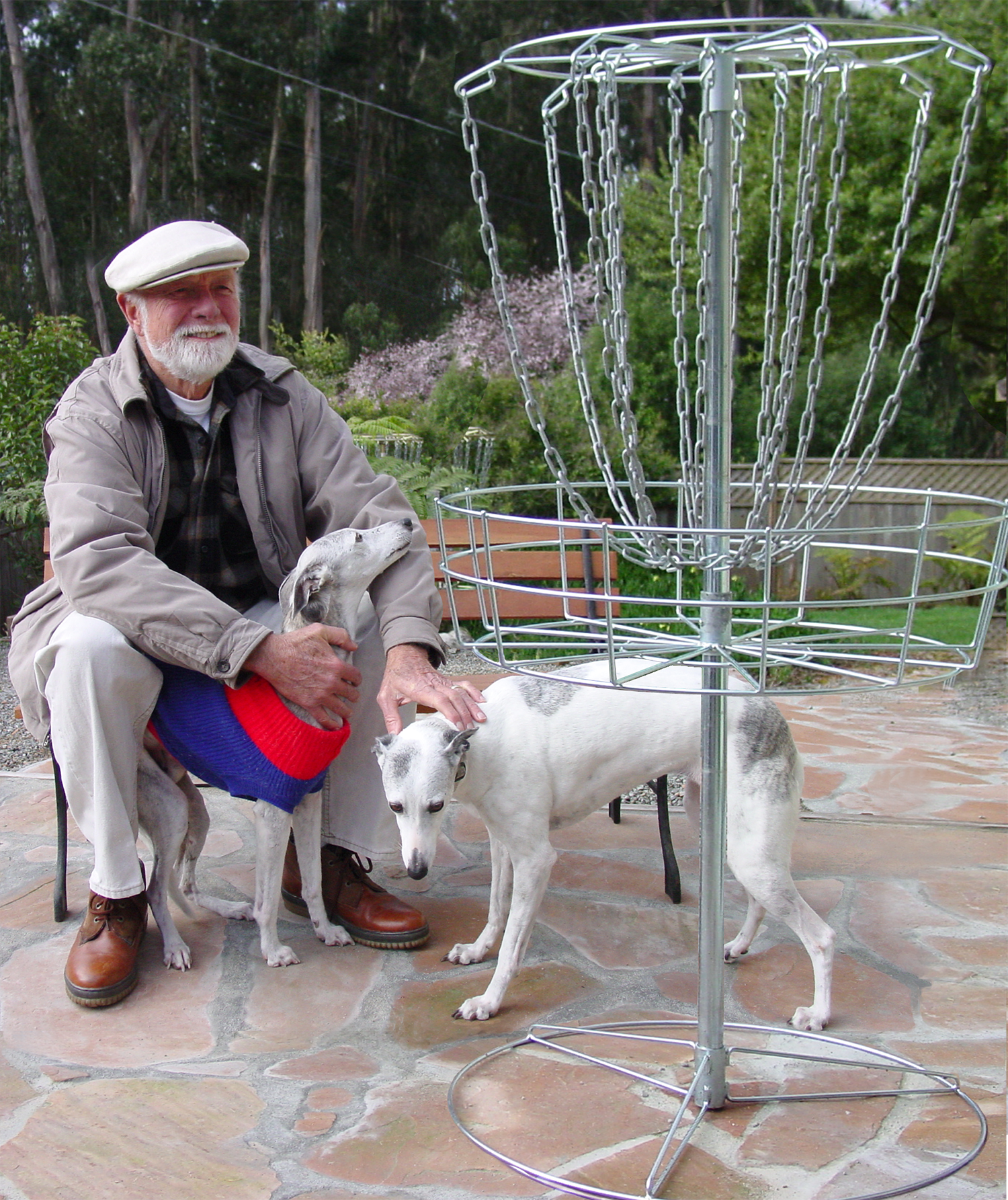
Believe it or not, Disc Golf goes all the way back to the early 1900s! Back then, frisbee games were played just for fun. But the 1960s saw the sport begin to change & morph into a more athletic and competitive pursuit. Soon enough, there were thousands of dedicated enthusiasts to this sport, who all wanted to bring the excitement and challenge of normal golf to those who prefer a more “floaty” approach!
No overview of Disc Golf would be complete without mentioning one man: Ed Headrick, also known as “Steady” Ed Headrick. As an American toy inventor, he (get this) not only invented the “Frisbee” (that alone would put him head & shoulders above the rest), but he then went on to invent & trademark Disc Golf, disc types, the Disc Golf Association (DGA) AND (with his son) the hanging chain scoring baskets!
Ed and his company DGA revised and obtained patents for basket designs until his death in 2002. Today there are over 13,000 courses installed throughout the world, the majority of them using baskets modeled on the Disc Pole Hole DGA baskets Headrick designed.
Over the ensuing decades, Disc Golf has remained true to Ed’s vision of it – as a fun, inclusive outside activity that can be enjoyed by people of all ages & skill levels. The thousands playing today all over the world are a testament to its enduring appeal, the passion of the Disc Golf community, and Ed’s incredible insight into what makes a good, enjoyable game.
What an incredible legacy he left on the world!!
If Disc Golf is so fun and challenging… how the heck d’ya play it??
Easy. Players to throw a frisbee-like disc into a target basket or pole hole in as few throws as possible. Understanding the basic rules of disc golf is essential for enjoying the game and playing it fairly and not ticking off your partner! LoL
The first rule of disc golf is to throw your disc from the tee pad towards the target, which can be a basket or a pole hole. The player who completes the course with the fewest number of throws wins the game. In addition to the basic rules of the game, there are also several important safety rules to keep in mind, such as being aware of other players and staying behind them while they are throwing.

Another important rule is that players must throw their disc from where it lands after each throw. If your disc lands out of bounds, you’ll need to move it back to the point where it crossed the out-of-bounds line and take a one-throw penalty.
There are also specific rules regarding the different types of discs used in the game. For example, there are rules regarding the maximum weight and size of discs, as well as the number of discs that can be carried during a game.
By understanding the basic rules of disc golf, you can enjoy the game safely and fairly, and even compete in tournaments and events with confidence.
So now that you know what Disc Golf is, AND how to play it, all you need now is… the “right stuff“!
One of the great things about Disc Golf is that you can literally just start playing with ONE DISC and nothing else. As long as you’ve got a hefty round platter to toss from your hand… you’re good!
But, of course, if you really want to play the sport effectively, and get better over time, you should invest a weeee bit more into the basics.
In the perfect disc world, here’s what we suggest if you wanna do well right from the get-go…
The most important pieces of equipment for disc golf are the discs themselves. Players typically use three types of discs, each one being specialized for certain types of throws, & specific flight paths, over various distances.
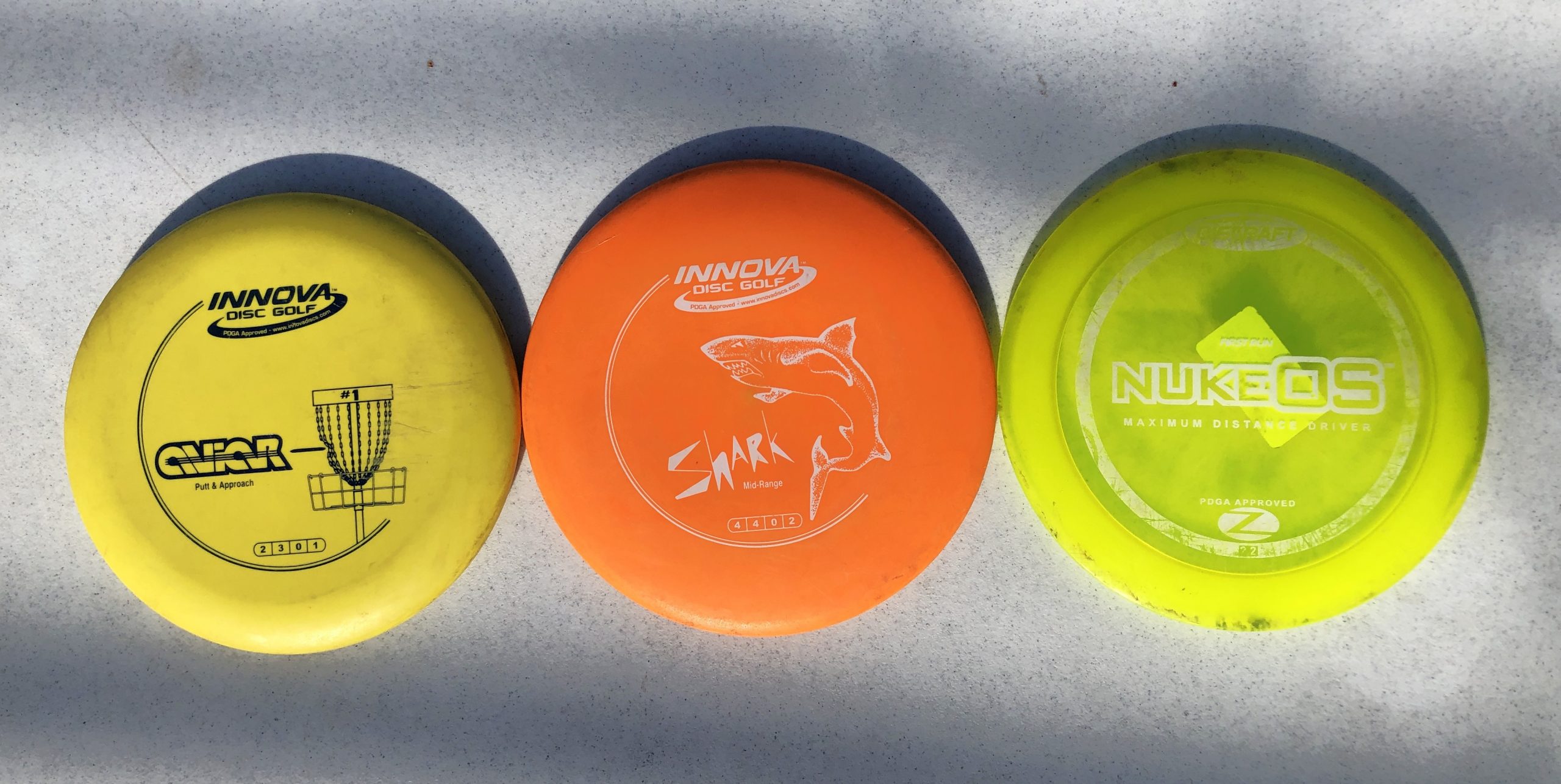
Your most critical disc is your DRIVER. Drivers are designed for long-distance throws and are the most aerodynamic of the three types. They typically have a sharper edge and a more rounded bottom, which makes them travel farther and faster through the air. Drivers are the go-to choice for shots that require maximum distance, such as tee shots on long holes.
Next, you’ll want a MID-RANGE disc. these are designed for shorter throws and offer more control and accuracy than drivers. They are generally more stable and have a straighter flight path than drivers. Mid-range discs are ideal for shots that require more precision, such as approach shots to the green, distances like a car driveway up to a backyard.
Finally, the all-important PUTTER is definitely a disc you want in your arsenal… but only if you want to win! Putters are designed for short-range throws and are the most accurate of the three types. They have a blunt edge and a shallow rim, which makes them ideal for precise and controlled throws. If you’re near the basket and you want the optimal odds for getting your disc in, a Putter is your best choice & best friend.
And what about what they’re made of? Well, in addition to each disc’s unique flight characteristics, they also come in various plastic blends. Each blend offers different levels of stiffness, grip, and durability, which can affect the disc’s flight path and overall performance. Your preference you’ll come to figure out the more you play with each type.

So, in a nutshell, different disc types help you achieve the distance and accuracy needed for varying shots. Understanding the nuances between these three types of discs, and practicing with them, will most assuredly help you improve your game and take your disc golf skills to the next level.
Oh, one more thing… out on the Disc Golf course, you’ll see some more advanced players carrying SOOOOOO many discs. It’s so extreme, I’ve even seen a dude with TWO BAGS full. Don’t worry; you really don’t need that many. They just really like their discs, and having just the right options.
It’s just like anything, the more you like something… the more of it you must have! LoL
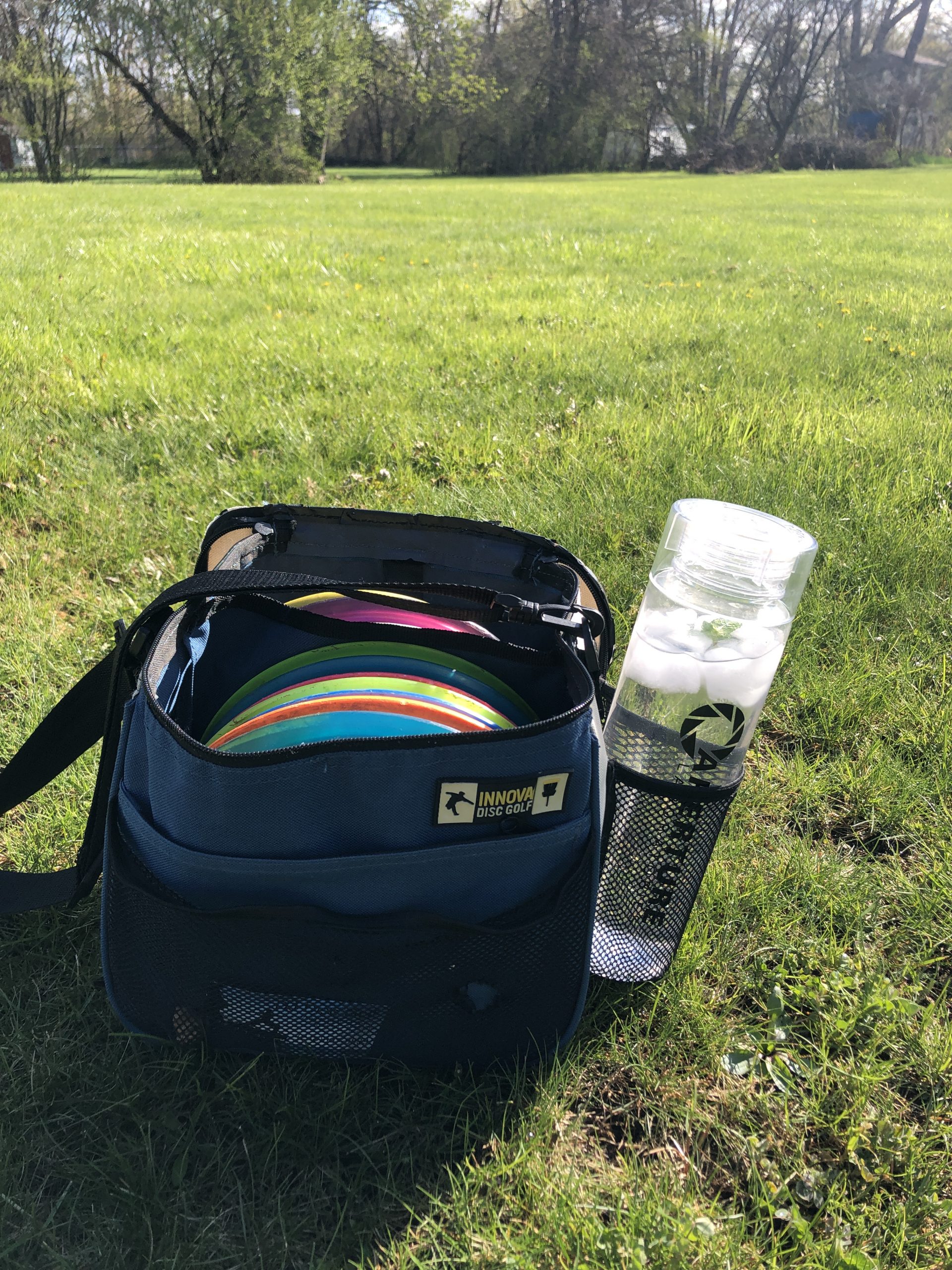
Once you have some discs, you’ll want something to keep ’em in. Being able to store and transport your discs comfortably might not seem needful, but if you’re going to play a full course of 18 holes, believe us when we say you really will be glad to got a Disc Bag.
They come in various sizes and styles, and are designed to hold multiple discs as well as a few asundry other things, like your phone, a towel to wipe your hands and discs dry, a water bottle to stay hydrated during games, etc.
Most come with comfortable straps and plenty of room to hold a normal set of typical discs. As you need more room, you can always upgrade. And you probably will, ’cause once you start playing Disc Golf, it gets very addicting!
One thing’s for sure, you will be walking… a LOT. You’ll thank yourself later if you slip your feet into the appropriate footwear.
In disc golf you’ll often find yourself traversing uneven terrain, and many different surface types. Shoes with good traction and support not only prevent injuries and improve your performance on the course, they keep you from spending the rest of day at home tending to shin splints or other “ouchies” that you can easily prevent with supportive shoes.
Make sure your shoe or boot choice provides a good grip on different surfaces, such as dirt, grass, pavement or concrete. They should also have a comfortable fit to prevent blisters or foot fatigue during long rounds. Consistent traction will definitely help you maintain your balance and footing while throwing, & thus help you achieve the accuracy and power needed to be the winner in your team. Not that it’s all about competition. But, hey, if you can win… why not go for it?!
When you first go out to play a Disc Golf course, it may be a little confusing. Some courses are excellent at marking the different holes with signage. Others… not so much. Add to that the fact that much of the time you’ll be playing in an area with a lot of TREES, and you can see why sometimes it’ll seem that those darn hanging chain targets are playing hide-and-seek with you!
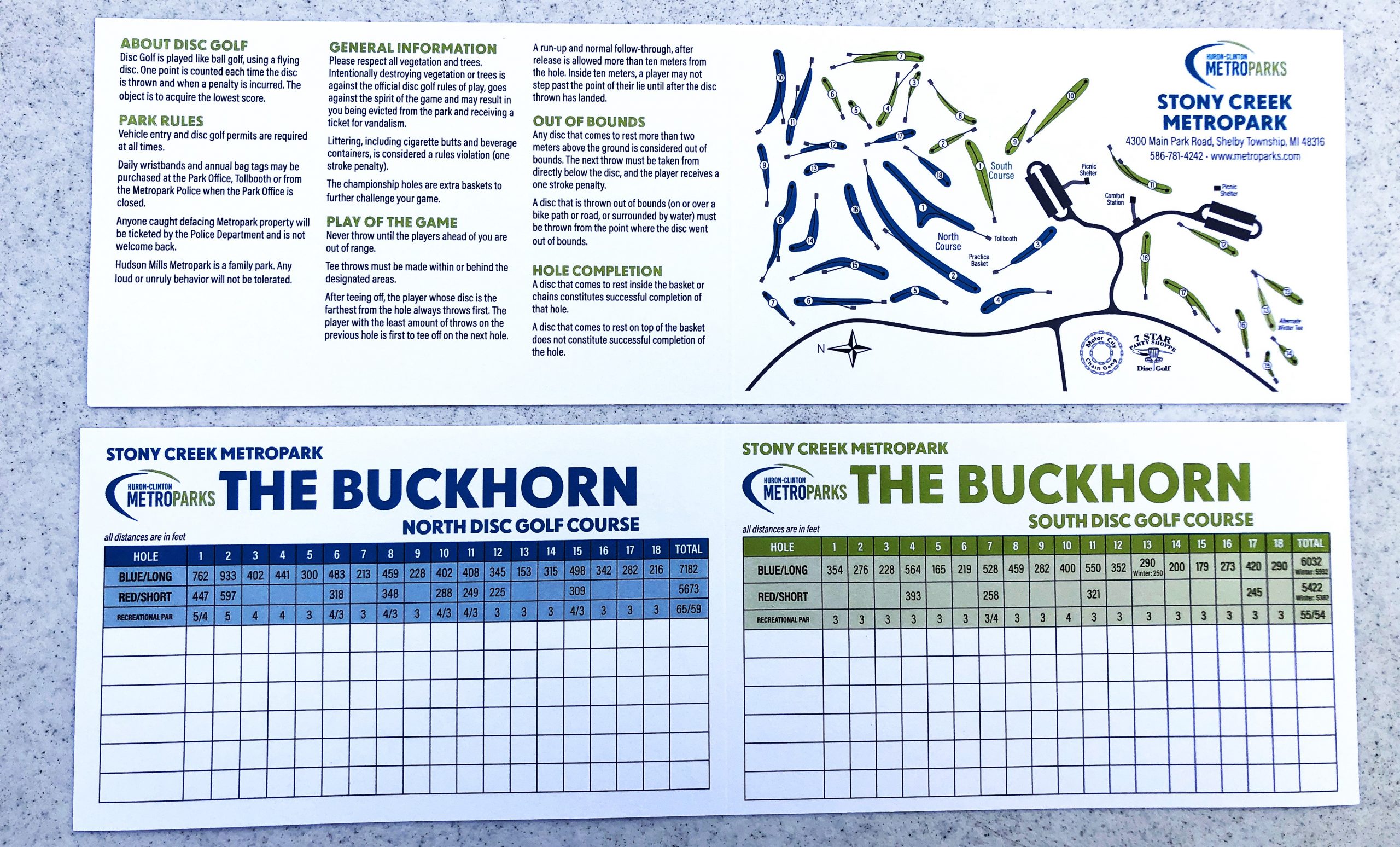
So take our advice and Google your course before you head out. Then download, or have on your phone at the ready, a Course Map. Especially if you’re in totally unfamiliar territory, you’ll really appreciate having the layout at the ready to show you where each hole is and where to go next.
We’ve found that it’s the rare sight that actually will have printed paper course maps. Thus, do yourself a big favor and get a map online, or in a disc golf app (of which there are quite a few).
Once you have those three things, you’re good to go! As you improve your skills, you can add more specialized discs to your collection, bling out your Disc Bag to keep your finest flying beauties in, play courses all over your city, state & even country. The sky’s the disc-flyin’ limit. So get in on the action & start flingin’ your favorite towards the chains!
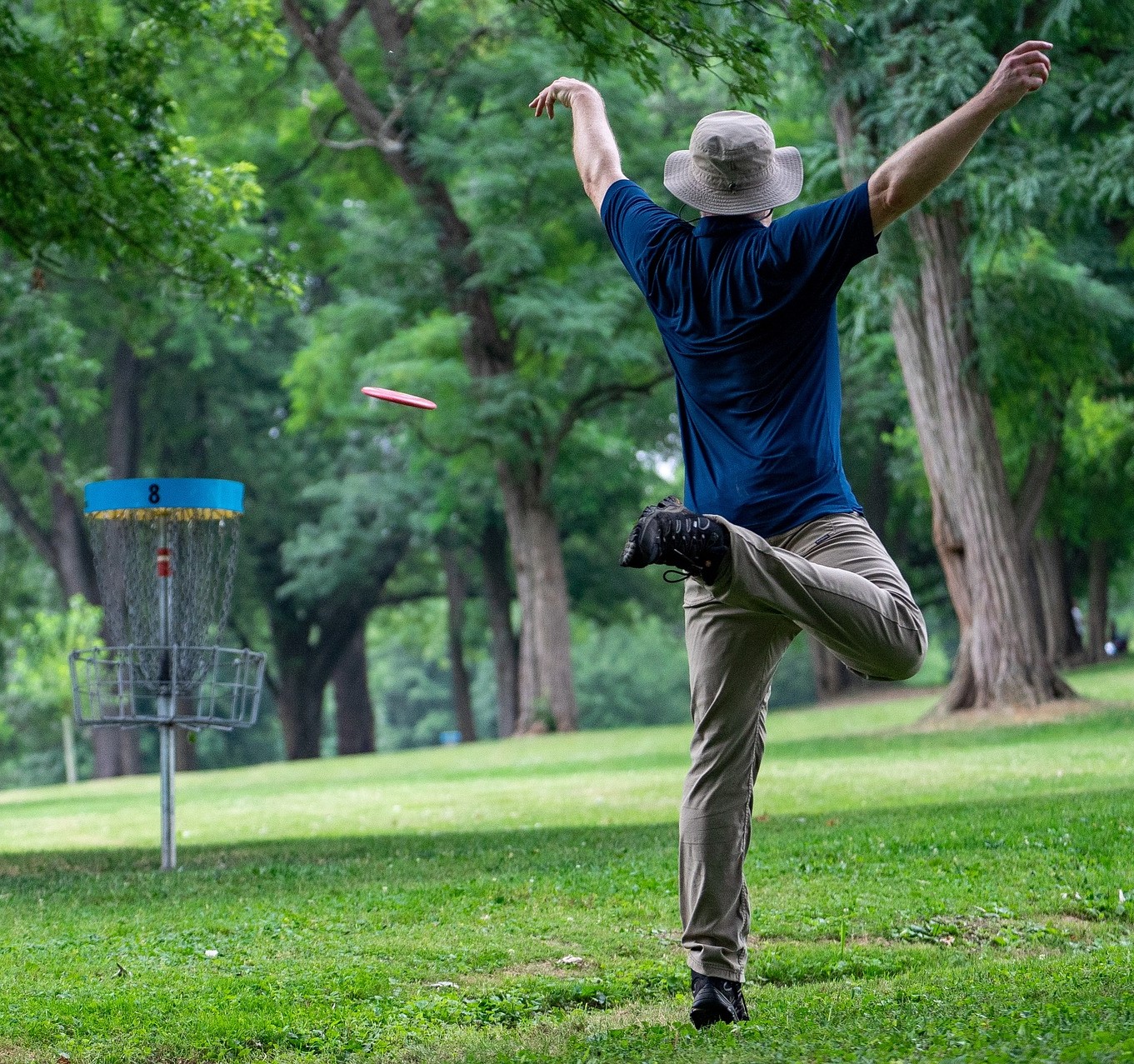
We recommend to start with a starter set that includes everything you need. These save you money, compared to buying each thing separately. It also saves you a lot of time, allowing you to get out & get playing right away so you can discover just how entertaining & fun this sport is.
Our most popular Beginner’s Disc Golf Set is THIS ONE by Crown. It’ll have you looking like a true Disc Golf veteran to everyone vying for the chain-clangin’ prize!
Okay, so, just like any other sport, Disc Golf has words & phrases that may be totally new & a bit confusing to you. Knowing what things are called will help you fit in and understand the ‘disc lingo’ as you play, so we’re here to save the day! Here’s our list of most of the common disc golf terms you’ll come across as you play this exciting sport:
Start incorporating these terms into your course banter between you & your friends. Even print this list out or keep it viewable on your phone. In no time you’ll find yourself understanding these terminologies & better communicating your shots & goals with other players, which will in turn help them to understand the rules & terminologies of the game better too.
Now that you’re just itchin’ to get flingin’ some discs, let’s pretend you’re ready to go play your first game. What do you do? Let us walk you through it step-by-step:
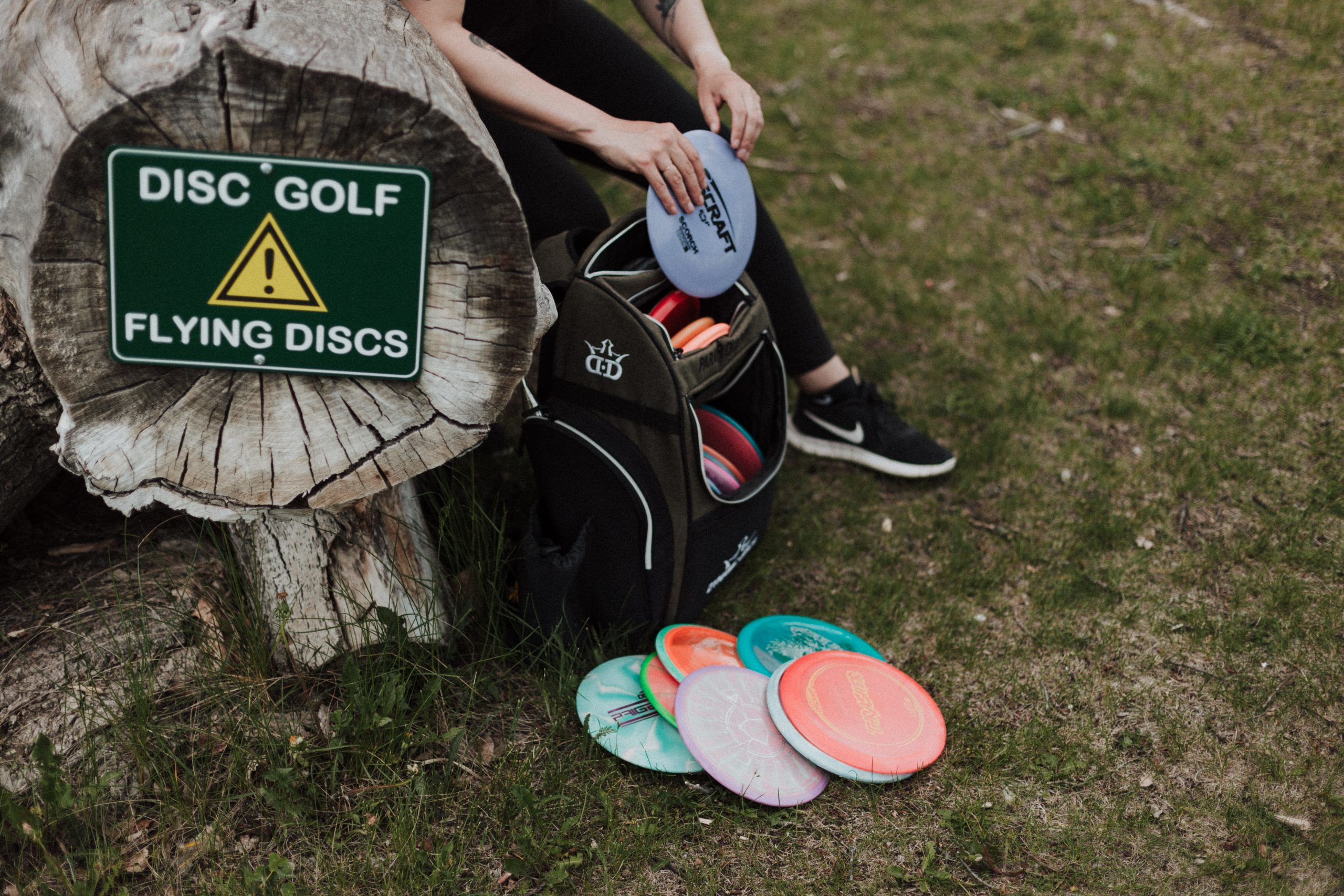
Step 1: Print out the Course Map or call it up on your phone to keep handy during the game should you need it. Decided whether you’re going to keep it light for your very first outing & only shoot 9 holes (half a normal course) or go the full monty and conquer the full 18-hole course.
Step 2: Assemble your game gear. Make sure you have your discs, your bag, comfortable shoes, and any other thing you deem necessary (music player for personal invigoration?!).
Step 3: Drive (or walk or bike, like my son & I do to a course that’s just two blocks away) to the course.
Step 4: Approach the first Tee. If others are on it, wait for them to leave.
Step 5: Set down your bag & choose the disc you want to use for your first throw, based on your distance from the first basket & any obstacles between you & the hole. Do NOT throw, however, until any teams in front of you have taken ALL their discs from the basket ahead and moved on to Tee 2. You never want to hit anyone, or interfere with their game by confusing them with your disc.
Step 6: Take aim & THROW THAT DISC!! Try to make it land as close to the basket as possible.
Step 7: Let any others on your team throw their first disc.
Step 8: When all have thrown, go out and find where your discs landed. Each member of your team will now throw in order of how FAR they are from the basket. The one whose disc is farthest from the basket goes first, then the next farthest, etc. Always throw from where your disc landed. One foot MUST be on that spot when you throw.
Step 9: All on your team keep throwing until all discs are successfully thrown into the basket.
Step 10: Keep track of your score. Each hole has a designated par, which represents the number of throws expected to complete the hole. Keep track of the number of throws it takes to get the disc into the basket, and add them up at the end of the game. Whoever has the LOWEST number is the winner.
Step 11: Continue the game, repeating these steps at each hole, and following the rules and etiquette of the game. Respect other players, leave the course in good condition, and don’t make too much noise so teams can concentrate on their throws.
May the best Disc-er win!!
If you’ve never looked at Disc Golf discs, prepare yourself… there are literally THOUSANDS of choices out there. Not only is mega-confusing when purchasing discs, you can even feel lost when trying to pick a disc right there on the course. So how do you do it?
Don’t let the options overwhelm you. As long as you understand disc basics, you can easily make an informed decision, whether for buying, OR for throwing.
Here are your basic considerations to remember:
Obviously, you can’t really play disc golf without a true Disc Golf course. So where are they? And how do you find one??
As you guessed, Google is king of this kind of info. But we’re even better! Go straight to the online course directories put out by the Professional Disc Golf Association (PDGA) by CLICKING HERE. They maintain a comprehensive list of courses around the world on their website, so you’re sure to find some good ones near you.

You can also use popular course directory APPS, such as UDisc, Disc Golf Course Review, or DG Course Review, which provide user-generated reviews and ratings, & help you choose the best course for your level of expertise or (ahem) non-expertise.
Also, check with your local parks and recreation department or community center. They probably have info about local disc golf courses and events, as well as rental discs for beginners who don’t have their own equipment yet.
If you’re still having trouble finding a place to play near you, consider joining a local disc golf club or league. These groups can be found through Google, social media or the PDGA website. The maxim stays true through history: if you want to be good at something, hang around other people who already are!
Once you’ve found a course, be sure to review the course layout and rules before playing. Then… just go for it! Have fun and enjoy the great outdoors and the thrill & comraderie that playing disc golf always brings.
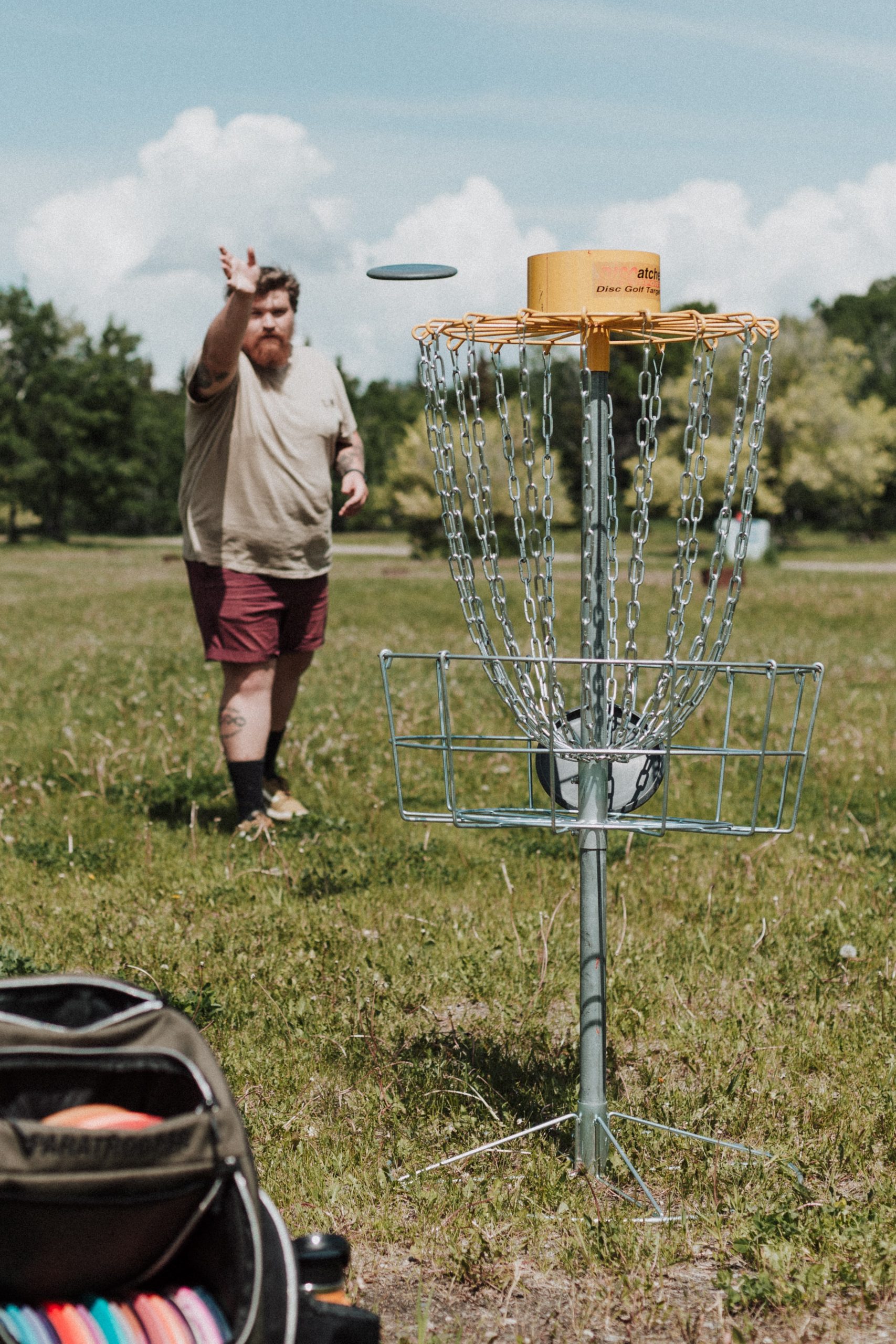
Just like any sport, Disc Golf has its own set of etiquette rules. These are ways of playing that players follow in order to ensure a safe and enjoyable experience for everyone on the course. Here are the biggest ways to ensure you don’t embarrass yourself, & your team, while out on the course:
Simple, right? Kind of common sense, really, but they bear repeating. Follow these rules of Disc Golf etiquette, & you will help create a positive and enjoyable experience for yourself, and all others, on the vibrant course.
For those of you who, like me, actually have played disc golf, and maybe would like to get better, guess what? There are lots of little, more advanced, techniques that can take your game to the next level.
This is especially important if your significant other, sons, daughters or friends keep beating you on the course. Not that I’ve ever experienced that, of course. Nope, not me. Never.
No matter what my son says. LOL
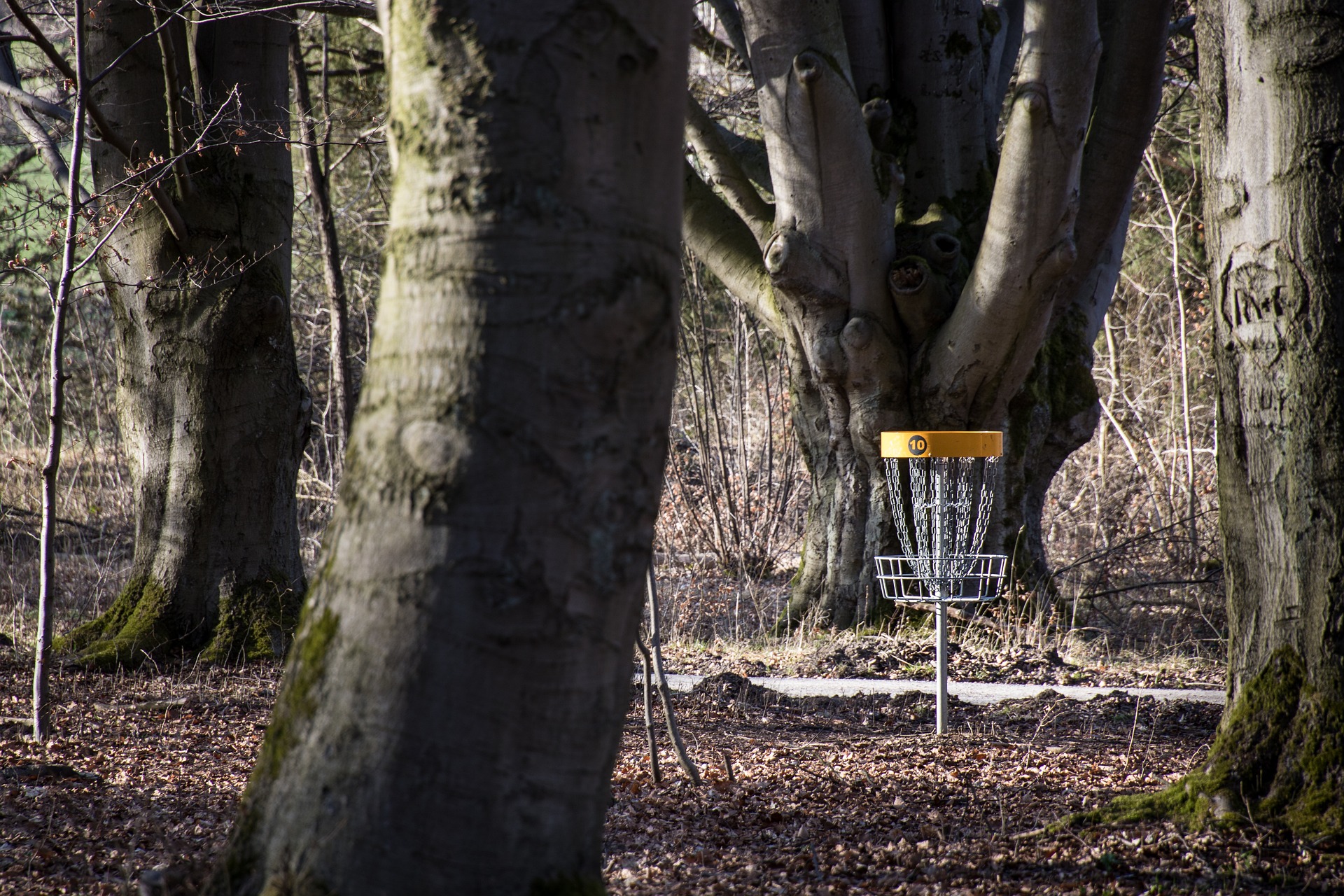
So here are some tips (for all of us!) if you want to master some advanced techniques and improve your chances of making a hole-in-one:
There’s a ton of other advanced techniques out there too. Every experienced player on the Internet has their own little “secrets” that took their game to the next level and increased their chances of slamming a hole-in-one.
Above all, keep practicing, keep experimenting & find what works best for you. Everybody’s arms, wrists & hands are different, so only you can unlock what’s behind your own “disc mastery” door!

Okay, so Disc Golf is fun. But why? Well, one of the biggest reasons is that your body is loving all the health benefits that come with it! Both your mind and your body are improved in significant ways just by all that walking, talking, throwing and striving for the win:
So go ahead – sharpen your physical fitness, hone your mental focus, and bodaciously boost your overall well-being by going & playing a round of Disc Golf. Whether you’re a beginner, or more experienced, the course is calling your name.
We did it! We traversed this virtual Disc Golf Course of insights & inspirations and made it to the end.
That was so much fun I wanna do it again. Kinda like playing… DISC GOLF!!
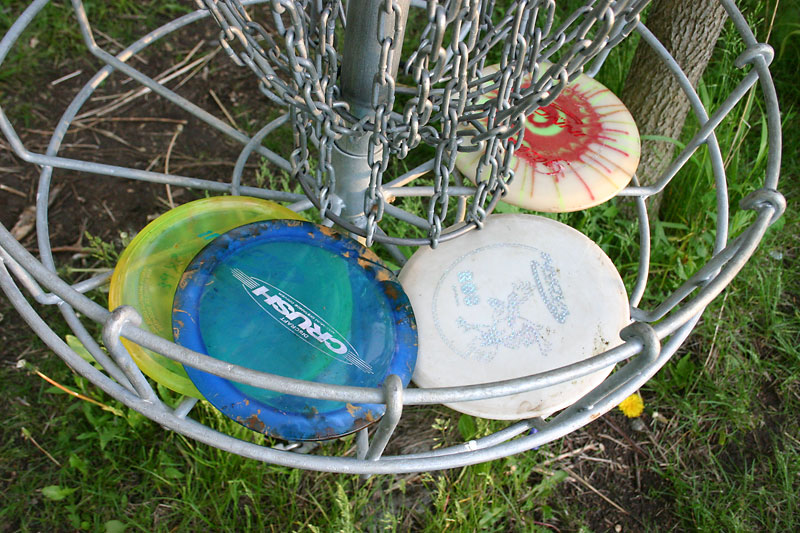
I hope you enjoyed this Introduction to Disc Golf as much as I did writing it. This game has brought my family & friends such joy, laughter & comraderie over the years, I can’t wait for you to try it & experience the same.
Lemme know if you do. I’d love to hear what you thought, how ya did & who ya did it with.
Even if you do have to fish your disc out of a river. Something I’ve neeeeeeever done. No, no, never.
No matter what my son tells you. LOL
See you outside!!
TJ
CEO, the Outdoor Hobby Hub